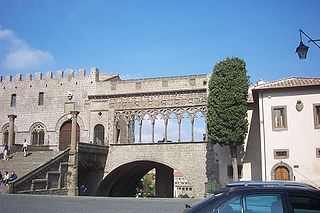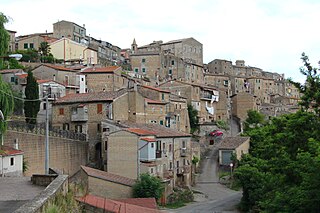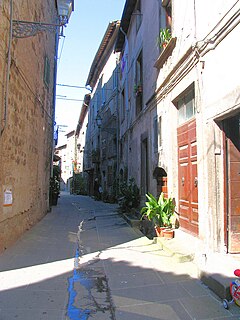Related Research Articles

Viterbo is an ancient city and comune in the Lazio region of central Italy, the capital of the province of Viterbo.

Viterbo is a province in the Lazio region of Italy. Its capital is the city of Viterbo.

Ronciglione is a city and comune in the province of Viterbo, Lazio, about 20 kilometres (12 mi) from Viterbo. The city is located in the Cimini mountains, over two tuff scarps, on the SE slope of the former volcano crater now housing the Lake Vico.

Bassano Romano is a town and comune situated in the hills of Monti Sabatini in the province of Viterbo, in northern Lazio (Italy). With its origins about 1000 as the agricultural hamlet of Bassano di Sutri the village's future was founded in 1160 by the wealthy landowner Enotrio Serco, who initiated the construction at the top of the slope of a fortified residence that over the centuries became a princely dwelling, frescoed by famous artists. In 1482 Pope Sixtus IV assigned the Foedus Bassani to the Anguillara, Roman patricians . The growth of the comune redoubled after 1565, when the signory was reassigned by Pope Clement VIII to the Giustiniani, merchants of Genoese origin settled at Rome. In 1605 the signory was raised to a marquessate: a hunting lodge called "La Rocca", granaries, a stone bridge and the church dedicated to San Vincenzo were all constructed. During the Giustiniani residence, artists were commissioned to carry out frescoes: Francesco Albani, Domenico Zampieri "Domenichino" and Antonio Tempesta are all represented. In 1644, a bulla of Pope Innocent X made the marchese of Bassano a prince, and the flock of papal and noble visitors included James Stuart, pretender to the thrones of England and Scotland. In 1735, under Giustiniani patronage the maiolica manufactory of Bartolomeo Terchi was transferred here from Siena.

Fabrica di Roma is a comune (municipality) in the Province of Viterbo in the Italian region Latium, located about 55 kilometres (34 mi) northwest of Rome and about 25 kilometres (16 mi) south-east of Viterbo.

Onano is a comune (municipality) in the Province of Viterbo in the Italian region Lazio, located about 100 kilometres (62 mi) northwest of Rome and about 40 kilometres (25 mi) northwest of Viterbo.

Oriolo Romano is a comune (municipality) in the Province of Viterbo in the Italian region Latium, located about 40 kilometres (25 mi) northwest of Rome and about 30 kilometres (19 mi) south of Viterbo on a hilly area near the ancient Via Clodia.

Vitorchiano is a comune (municipality) in the Province of Viterbo in the Italian region Latium, located about 70 kilometres (43 mi) northwest of Rome and about 7 kilometres (4 mi) northeast of Viterbo. As of 31 December 2004, it had a population of 3,690 and an area of 29.8 square kilometres (11.5 sq mi).

Giovanni Francesco Romanelli was a major Italian painter of the Baroque period, celebrated for his use of bright, vivid colors and also for his clarity of detail. Many of his works are on display in the Louvre.

Marcello Venusti was an Italian Mannerist painter active in Rome in the mid-16th century.

With a long history as a vantage point for anti-popes forces threatening Rome, Viterbo became a papal city in 1243. During the later thirteenth century, the ancient Italian city of Viterbo was the site of five papal elections and the residence of seven popes and their Curias, and it remains the location of four papal tombs. These popes resided in the Palazzo dei Papi di Viterbo alongside the Viterbo Cathedral intermittently for two decades, from 1257 to 1281; as a result, the papal palace in Viterbo, with that in Orvieto, are the most extensive thirteenth-century papal palaces to have survived.

Orvieto, Umbria, Italy, was the refuge of five popes during the 13th century: Urban IV (1261–1264), Gregory X (1271–1276), Martin IV (1281–1285), Nicholas IV (1288–1292) and Boniface VIII (1294–1303). During this time, the popes took up residence in the Papal Palace of Orvieto, which was adjacent to the Orvieto Cathedral and expanded onto the bishop's residence. None of these popes died in Orvieto, and thus no papal elections took place in there, nor are there any papal tombs.

Antonio del Massaro da Viterbo, or Antonio da Viterbo, nicknamed il Pastura was an Italian painter.

The Basilica of St. Francis is a parish church and minor basilica in Viterbo, central Italy. The museological management of the church is run by the Polo Museale del Lazio.

Marzio di Colantonio or di Colantonio Ganassini or di Cola Antonio was an Italian painter, as a painter of still-lifes and landscapes, and fresco decorations of grotteschi and battle scenes with small figures. His still-life paintings contain hunted game.
Giacomo Cordelli was an Italian painter, active circa 1600–1620.

Lorenzo da Viterbo was, together with Antoniazzo Romano, the greatest native painter of the early Renaissance in the region of Rome.

Francesco d’Antonio Zacchi, also known as il Balletta, was an Italian painter of the late-Gothic and early-Renaissance style active in Viterbo, region of Lazio, Italy. He is also called Francesco d'Antonio da Viterbo.

The Basilica of Santa Maria della Quercia is a Renaissance-style, Roman Catholic sanctuary church and minor basilica, about two kilometer outside of the center of Viterbo, on the road to Bagnaia, in the Region of Lazio, Italy.
References
- ↑ Lazio, non compresa Roma e dintorni; edited by Touring club italiano page 253.
- ↑ Brevi Notizie della città di Viterbo e degli uomini illustri dalla medesima; by Gaetano Coretini, Stamperia di San Michele a Ripa Grande, presso paolo Giunchi, (1774), page 129